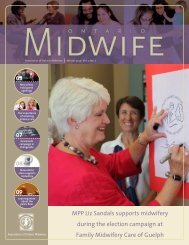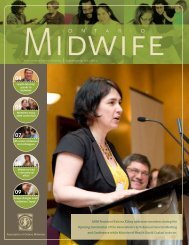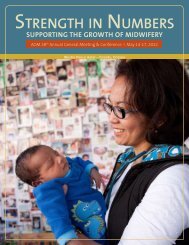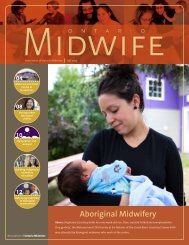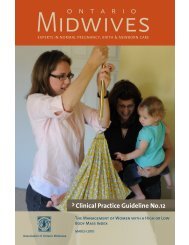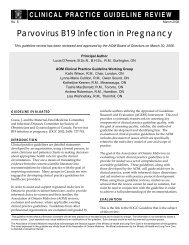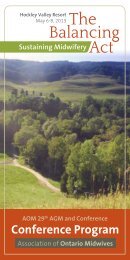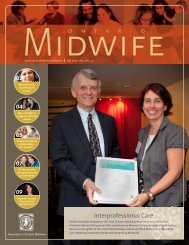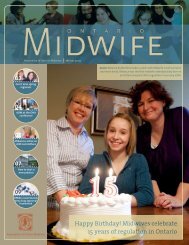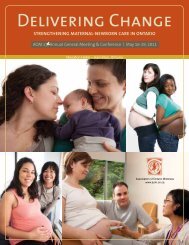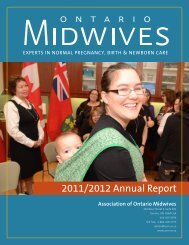Management of the Uncomplicated Pregnancy ... - Ontario Midwives
Management of the Uncomplicated Pregnancy ... - Ontario Midwives
Management of the Uncomplicated Pregnancy ... - Ontario Midwives
- No tags were found...
You also want an ePaper? Increase the reach of your titles
YUMPU automatically turns print PDFs into web optimized ePapers that Google loves.
<strong>Midwives</strong>o n t a r i oExperts in normal pregnancy, birth & newborn care> Clinical Practice Guideline No.10Association <strong>of</strong> <strong>Ontario</strong> <strong>Midwives</strong><strong>Management</strong> <strong>of</strong> <strong>the</strong> <strong>Uncomplicated</strong> <strong>Pregnancy</strong>Beyond 41+0 Weeks’ Gestationfebruary 2010
Clinical Practice Guideline No.10<strong>Management</strong> <strong>of</strong> <strong>the</strong> <strong>Uncomplicated</strong> <strong>Pregnancy</strong>Beyond 41+0 Weeks’ GestationAuthorsJulie Corey, RM MHScTasha MacDonald, RM MHScAOM StaffSuzannah Bennett, MHScCindy Hutchinson, MScBobbi Soderstrom, RMContributorsClinical Practice Guideline SubcommitteeElizabeth Darling, RM MSc, ChairCheryllee Bourgeois, RMCorinne Hare, RMAcknowledgementsKristen Dennis, RM<strong>Ontario</strong> Ministry <strong>of</strong> Health and Long-term CareRyerson University Midwifery Education ProgramJenni Huntly, RMPaula Salehi, RMLynlee Spencer, BScVicki Van Wagner, RM, PhD (c)Rhea Wilson, RMInsurance and Risk <strong>Management</strong> ProgramSteering Committee‘Remi Ejiwunmi, RM, ChairThe Association <strong>of</strong> <strong>Ontario</strong> <strong>Midwives</strong> respectfullyacknowledges <strong>the</strong> financial support <strong>of</strong> <strong>the</strong> Ministry<strong>of</strong> Health and Long-Term Care in <strong>the</strong> development<strong>of</strong> this guideline.The views expressed in this guideline are strictlythose <strong>of</strong> <strong>the</strong> Association <strong>of</strong> <strong>Ontario</strong> <strong>Midwives</strong>. No<strong>of</strong>ficial endorsement by <strong>the</strong> Ministry <strong>of</strong> Health andLong-Term Care is intended or should be inferred.Abigail Corbin, RMElana Johnston, RMCarolynn Prior van Fraassen, RMLisa M Weston, RMAssociation <strong>of</strong> <strong>Ontario</strong> <strong>Midwives</strong>365 Bloor St. E., Suite 301Toronto, ON M4W 3L4www.aom.on.ca
AOM Clinical Practice Guideline<strong>Management</strong> <strong>of</strong> <strong>the</strong> <strong>Uncomplicated</strong> <strong>Pregnancy</strong>Beyond 41+0 Weeks’ GestationThis guideline was approved by <strong>the</strong> AOM Board <strong>of</strong> Directors: February 17, 2010Statement <strong>of</strong> purpose:The goal is to provide an evidence-based clinicalpractice guideline (CPG) that is consistent with<strong>the</strong> midwifery philosophy <strong>of</strong> care. <strong>Midwives</strong> areencouraged to use this CPG as a tool in clinicaldecision-making.Objectives:To provide a critical review <strong>of</strong> <strong>the</strong> researchliterature for women reaching 41+0 weeks’gestation and beyond in an uncomplicatedpregnancy, as well as to providerecommendations regarding managementoptions. Evidence relating to <strong>the</strong> following willbe discussed:• Factors contributing to an increased risk <strong>of</strong>postdates pregnancy• Effective interventions for reducing <strong>the</strong>rate <strong>of</strong> postdates pregnancy• Impact <strong>of</strong> postdates pregnancy onmaternal and neonatal outcomes• <strong>Management</strong> options for postdatespregnancy.Outcomes <strong>of</strong> interest:1.2.Maternal outcomes: rate <strong>of</strong> caesareansection, instrumental delivery, morbidity,satisfaction with careNeonatal outcomes: perinatal mortality,perinatal morbidityMethods:A search <strong>of</strong> <strong>the</strong> Medline database and Cochranelibrary from 1994-2009 was conducted using<strong>the</strong> key words: prolonged pregnancy, postdatespregnancy, postterm pregnancy. Additionalsearch terms were used to provide moredetail on individual topics as <strong>the</strong>y related topostdates pregnancy: antenatal monitoring,fetal movement counting, evening primroseoil and gestational age calculation. Olderpublications were accessed to include seminalrandomized controlled trials, commonly citedsources for incidence rates or studies that hadsignificant impact on clinical practice. Evidencewas graded using <strong>the</strong> Canadian Task Force onPreventive Health Care grading system. (1)Review:This guideline was reviewed using a modifiedversion <strong>of</strong> <strong>the</strong> AGREE instrument (2), <strong>the</strong> AOM’sValues-based Approach to CPG Development(3), as well as consensus <strong>of</strong> <strong>the</strong> AOM CPG Subcommittee,<strong>the</strong> Insurance and Risk <strong>Management</strong>Program, and <strong>the</strong> AOM Board <strong>of</strong> Directors.This guideline reflects information consistent with <strong>the</strong> best evidence available as <strong>of</strong> <strong>the</strong> date issued and is subjectto change. The information in this guideline is not intended to dictate a course <strong>of</strong> action, but inform clinical decisionmaking.Local standards may cause practices to diverge from <strong>the</strong> suggestions within this guideline. If practicegroups develop practice group protocols that depart from a guideline, it is advisable to document <strong>the</strong> rationale for<strong>the</strong> departure.<strong>Midwives</strong> recognize that client expectations, preferences and interests are an essential component in clinicaldecision-making. Clients may choose a course <strong>of</strong> action that may differ from <strong>the</strong> recommendations in this guideline,within <strong>the</strong> context <strong>of</strong> informed choice. When clients choose a course <strong>of</strong> action that diverges from a clinical practiceguideline and/or practice group protocol this should be well documented in <strong>the</strong>ir charts.Clinical Practice Guideline: <strong>Pregnancy</strong> Beyond 41+0 Weeks 1
ABBREVIATIONS:CI – confidence intervalCS – caesarean sectionBMI – body mass indexBPP – biophysical pr<strong>of</strong>ileEDB – estimated date <strong>of</strong> birthLMP – last menstrual periodMAS – meconium aspiration syndromeMSAF – meconium stained amniotic fluidNNT – number needed to treatOR – odds ratioRR – relative riskT1 – first trimesterT2 – second trimesterKey to evidence statements and grading <strong>of</strong> recommendations, from <strong>the</strong> Canadian Task Forceon Preventive Health CareEvaluation <strong>of</strong> evidence criteriaIII-1II-2II-3IIIEvidence obtained from at leastone properly randomized controlledtrialEvidence from well-designedcontrolled trials withoutrandomizationEvidence from well-designed cohort(prospective or retrospective) orcase-control studies, preferablyfrom more than one centre orresearch groupEvidence obtained fromcomparisons between timesor places with or without <strong>the</strong>intervention. Dramatic results inuncontrolled experiments (suchas <strong>the</strong> results <strong>of</strong> treatment withpenicillin in <strong>the</strong> 1940s) could alsobe included in this categoryOpinions <strong>of</strong> respected authorities,based on clinical experience,descriptive studies, or reports <strong>of</strong>expert committeesClassification <strong>of</strong> recommendations criteriaABCCDELThere is good evidence torecommend <strong>the</strong> clinical preventiveactionThere is fair evidence torecommend <strong>the</strong> clinical preventiveactionThe existing evidence is conflictingand does not allow to make arecommendation for or againstuse <strong>of</strong> <strong>the</strong> clinical preventiveaction; however, o<strong>the</strong>r factors mayinfluence decision-makingThe existing evidence is conflictingand does not allow to make arecommendation for or againstuse <strong>of</strong> <strong>the</strong> clinical preventiveaction; however, o<strong>the</strong>r factors mayinfluence decision-makingThere is fair evidence torecommend against <strong>the</strong> clinicalpreventive actionThere is good evidence torecommend against <strong>the</strong> clinicalpreventive actionThere is insufficient evidence (inquantity or quality) to make arecommendation; however, o<strong>the</strong>rfactors may influence decisionmakingReference: (1)2 Association <strong>of</strong> <strong>Ontario</strong> <strong>Midwives</strong>
INTRODUCTION<strong>Pregnancy</strong> at 41+ weeks’ gestation is seen <strong>of</strong>tenin midwifery practice. Though it is generally anormal and healthy occurrence associated withgood outcomes for women and babies, pregnancyat 41+ weeks has been associated with increasedrisks <strong>of</strong> meconium stained amniotic fluid (MSAF),meconium aspiration syndrome (MAS), shoulderdystocia and stillbirth. Determining <strong>the</strong> bestmethod <strong>of</strong> calculating an estimated date <strong>of</strong> birth(EDB), effective monitoring <strong>of</strong> fetal well-being, andif, when and how to intervene to initiate labour areall important aspects <strong>of</strong> postdates pregnancy management.<strong>Midwives</strong> providing care for pregnancyat 41+ weeks’ gestation aim to avoid unnecessaryintervention while facilitating <strong>the</strong> best possibleoutcomes for mo<strong>the</strong>rs and babies.Discussing and implementing a plan for management<strong>of</strong> pregnancy at 41+ weeks is part <strong>of</strong> <strong>the</strong>informed choice process. In order to facilitate clientdecision-making regarding pregnancy at 41+weeks, midwives need to be aware <strong>of</strong> <strong>the</strong> risks andbenefits <strong>of</strong> interventions such as induction <strong>of</strong> labour,as well as <strong>of</strong> expectant management.Definition <strong>of</strong> TermsAccording to <strong>the</strong> internationally recommendeddefinitions endorsed by <strong>the</strong> World Health Organization(WHO) and <strong>the</strong> International Federation <strong>of</strong>Gynecology and Obstetrics (FIGO), ‘postterm’ pregnancyis defined as pregnancy lasting 42+0 weeks(≥ 294 days) or more. ‘Postdates’ pregnancy is definedas lasting 40+0 weeks plus one or more days(i.e. anytime past <strong>the</strong> estimated date <strong>of</strong> birth), and‘prolonged’ pregnancy is any pregnancy after 42+0weeks (or synonymous with postterm). (WHO1977, FIGO 1986, cited in (4))Considerable confusion arises, however, as ‘postterm’,‘postdates’ and ‘prolonged’ pregnancy tendto be used interchangeably in research literatureand textbooks, as well as by health care providers.The lack <strong>of</strong> precision in <strong>the</strong> use <strong>of</strong> <strong>the</strong> termsassociated with pregnancies that pass <strong>the</strong> EDB iswidespread and may lead to misunderstanding asdescribed by Murray Enkin:“Semantic problems have also contributedto <strong>the</strong> confusion in understanding<strong>of</strong> postterm pregnancy. The words‘postterm,’ ‘prolonged,’ ‘postdates’ and‘postmature’ are all used as synonymsbut are laden with different evaluativeundertones.” (5)Fur<strong>the</strong>r, this ambiguity in <strong>the</strong> use <strong>of</strong> terms associatedwith postdates pregnancy makes “accuratecompounding <strong>of</strong> <strong>the</strong> qualitative data” difficult. (6)Where possible, <strong>the</strong> gestational age upon whichresearch studies based <strong>the</strong>ir results will be specifiedin this CPG, but due to inconsistencies in <strong>the</strong>way data was collected, ga<strong>the</strong>red or reported, thislevel <strong>of</strong> accuracy in reporting outcomes accordingto gestational age is not always possible.Using specific language when communicatingwith o<strong>the</strong>r health care providers as well as helpingclients to understand <strong>the</strong>se terms will improveclarity when communicating management plansfor postdates pregnancies.Incidence <strong>of</strong> Postterm <strong>Pregnancy</strong>It is difficult to determine <strong>the</strong> true prevalence <strong>of</strong>postterm pregnancy because inaccurate pregnancydating tends to over-estimate incidence, andinduction <strong>of</strong> labour will reduce rates <strong>of</strong> postdates.Several retrospective studies that applied strict criteriafor pregnancy dating have reported rates <strong>of</strong>6% to 8% for postterm pregnancy. (7-9) StatisticsCanada data (1980-1995) showed an increase in<strong>the</strong> number <strong>of</strong> births at 41 weeks (11.9% in 1980to 16.3% in 1995) and a decrease at 42 or moreweeks (7.1% in 1980 to 2.9% in 1995) reflectingchanges in clinical practice for <strong>the</strong> management<strong>of</strong> postdates pregnancy in Canada during this timeperiod (10) and possibly due to <strong>the</strong> increasing use<strong>of</strong> ultrasound allowing for more accurate pregnancydating.Contributing Factors for <strong>Pregnancy</strong> ≥ 41+0Weeks’ GestationSeveral retrospective cohort studies have identifiedfactors that contribute to prolonged pregnancy.These include high body mass index (BMI),nulliparity, fetal male gender and a previous postterm(≥ 42+0 weeks) pregnancy. Two cohort studiesfound an inverse correlation between <strong>the</strong> rateClinical Practice Guideline: <strong>Pregnancy</strong> Beyond 41+0 Weeks 3
<strong>of</strong> spontaneous labour at term and first trimesterBMI: <strong>the</strong> chance <strong>of</strong> having a postterm pregnancygoes up as BMI increases (OR ranging from 1.24with a BMI <strong>of</strong> 25-29 to 1.52 with a BMI over 35;95% CI 1.28-1.82). (8,11)Pregnant women are more likely to have pregnancieslasting ≥ 41 weeks if <strong>the</strong> fetus is male than ifit is female. A retrospective study reviewed 82 484singleton births and found that <strong>the</strong>re was a higherrate <strong>of</strong> postdates pregnancies when <strong>the</strong> fetus wasmale (RR 1.41 at 42 weeks) and proposed that thismay be due to potential measurement bias (malefetuses are slightly larger on average and <strong>the</strong>reforeultrasound measurements may tend to interpret<strong>the</strong>m as being at a slightly later gestation).(12) Ano<strong>the</strong>r review (656 423 births) also found ahigher likelihood <strong>of</strong> postterm pregnancy when <strong>the</strong>fetus was male (OR 1.14 at 41 wks, 1.39 at 42 wks,1.50 at 43 wks) but concluded that measurementbias does not account for all <strong>of</strong> <strong>the</strong> increase andsuggested a gender-related component to <strong>the</strong> initiation<strong>of</strong> labour. (13) Some evidence suggests thatwomen are also more likely to have a posttermpregnancy when having <strong>the</strong>ir first baby (RR 1.35 -1.46) (9,14) or if <strong>the</strong>y have had a previous posttermpregnancy (RR 1.38 – 1.88). (4,15,16)Summary StatementNulliparity, high BMI, history <strong>of</strong> a previous postdatespregnancy and male fetal gender are all associatedwith a higher rate <strong>of</strong> postterm pregnancy. (II-2)MATERNAL COMPLICATIONS OFPOSTDATES PREGNANCYSeveral studies have examined <strong>the</strong> maternal complicationsassociated with postdates including instrumentaldelivery and caesarean section (CS).A Finnish retrospective population-based cohortstudy conducted from 1990-2000 (1678 posttermpregnancies) found that postterm pregnancy wasassociated with an increase in instrumental delivery(10.7% vs. 5.3%) (OR 1.97, 95% CI 1.06-1.37,p < .01). (9) Background data, obstetrical risk factorsand health behaviours were included in <strong>the</strong>analysis to limit <strong>the</strong> influence <strong>of</strong> confounding variables.Ano<strong>the</strong>r retrospective review <strong>of</strong> 36 160 lowrisk pregnancy outcomes from 1989-1997 in Israel,found an increase in CS with increasing gestationalage postdates (5.4% at 40 wks, 5.8% at 41 wks,7.9% at 42 wks, 8.2% at 43 wks). (7) Similarly, in aretrospective cohort study including 119 254 lowrisk pregnancies in California in <strong>the</strong> period 1995-1999, caesarean rates increased from a rate <strong>of</strong>9.0% at 40 weeks to 14.0% at 41 weeks and 21.7%at ≥ 42 weeks (p < .01). The authors controlled forlength <strong>of</strong> labour, induction <strong>of</strong> labour and type <strong>of</strong>anaes<strong>the</strong>sia using multivariate regression. (17) Theabove studies have demonstrated an associationwith increased rates <strong>of</strong> CS for postdates pregnancies,ra<strong>the</strong>r than demonstrating causation. Simplybeing aware that a woman is ‘postdates’ maycause health care providers to intervene more readily(due to labelling). (6)PERINATAL COMPLICATIONS OFPOSTDATES PREGNANCYPerinatal complications associated with pregnancy≥ 41+0 weeks include meconium stained amnioticfluid, meconium aspiration syndrome, shoulderdystocia and stillbirth.Three randomized controlled trials (comprising3407, 440 and 508 women respectively) found similarperinatal mortality rates in those induced at 41weeks and those managed expectantly who deliveredbetween 41 and 43 weeks’ gestation. (18-20)A large retrospective review <strong>of</strong> 408 631 births beyond41+0 weeks’ gestation from <strong>the</strong> NorwegianMedical Birth Registry (1999-2005) found <strong>the</strong> perinatalmortality rate increased with increasing gestationalage (0.18% at 41 weeks, 5.1% at 43 weeks),no data was given for 42 weeks. In this analysis,<strong>the</strong> number <strong>of</strong> inductions necessary (NNT) to avoidone intrauterine fetal death (IUFD) or perinataldeath at 41 weeks was determined to be 671 (95%CI: 571-794) and 195 at 43 weeks (95% CI: 84-600),p < .004. The authors note that <strong>the</strong>re is a downwardcurve in inductions needed to avoid perinataldeath and IUFD near 286 days gestation (42+2weeks), see Figure 1. (21) A population-based prospectivestudy <strong>of</strong> 17 493 singleton pregnancies,also from Norway (1989-1999), with a second-trimester ultrasound examination and delivery af-4 Association <strong>of</strong> <strong>Ontario</strong> <strong>Midwives</strong>
Figure 1: Numbers <strong>of</strong> inductions needed to avoid 1 IUFD and 1 perinataldeath according to gestational age. Data from <strong>the</strong> Medical Birth Registry<strong>of</strong> Norway (21)ter 37+0 gestational weeks found that <strong>the</strong> relativerisk for perinatal mortality per 1000 total births decreasedfrom week 37+0 until 41+0 weeks, reachinga nadir and <strong>the</strong>n increasing at week 42+0 (RR1.24 at 37 weeks, 1.0 at 40 weeks, 0.43 at 41 wksand 1.92 at 42 wks). The absolute risk <strong>of</strong> perinatalmortality in this study was similar to <strong>the</strong> NorwegianMedical Birth Registry review above (2.7/1000at 40 weeks, 1.18/1000 at 41 weeks and 5.23/1000at 42 weeks). (16)A retrospective review <strong>of</strong> 36 160 low-risk pregnanciesfound an increase in MSAF (17.5% at 40 wks,21.5% at 41 wks, 25% at 42 wks, 37.7% at 43 wks,p < .001). (7) Ano<strong>the</strong>r cohort study <strong>of</strong> 32 679 lowrisk,cephalic, singleton births delivered at ≥ 37+0weeks <strong>of</strong> gestation (1976-2001) found an increasein MAS (OR 2.18 at 40 wks, 3.35 at 41 wks, 4.09 at42 wks). (22) Multivariate analyses were used tocontrol for ethnicity, weight, age, economic statusand obstetrical history. A retrospective populationbased cohort study <strong>of</strong> 1678 postdates pregnanciesfrom one hospital in Finland (1990-2000) foundthat postterm pregnancy was associated with anincrease in meconium staining (21.2% vs. 12.8%;p < .01), and shoulder dystocia (4.1% vs. 2.4%,p < .01), but found no significant difference in perinatalmortality or morbidity. (9) It is important tonote that although <strong>the</strong> risk <strong>of</strong> complications risewith increasing gestational age past 41+0 weeks,<strong>the</strong> absolute risk <strong>of</strong> adverse events remains small(see Table 1).There is evidence that <strong>the</strong> risk <strong>of</strong> an adverse outcomeis greater for smaller postterm babies. Alarge retrospective study (510 029 singleton termand postdates births) found that postterm smallfor gestational age (SGA) babies are at higher risk<strong>of</strong> stillbirth, compared with postterm appropriatefor gestational age babies (OR 10.56; 95% CI 6.95- 16.05) and that <strong>the</strong> rate <strong>of</strong> SGA babies is higherin <strong>the</strong> postterm period (3.8%) compared to at termClinical Practice Guideline: <strong>Pregnancy</strong> Beyond 41+0 Weeks 5
Table 1: Risk <strong>of</strong> Fetal Complications by Gestational Age: PerinatalComplications per 1000 birthsComplication(Study Country)Meconium StainedAmniotic Fluid (Israel)N=30 478 (7)Meconium AspirationSyndrome (Norway)N=27 514 (23)Gestational age (weeks)40 41 42 43Fetal complication / 1000 births175 215 250 N/A2.9 5.1 4.7 N/ANeonatal deaths‡/ Stillbirths*(Calculated separately by <strong>the</strong>authors) (United Kingdom)N= 171 527 (24)Perinatal Mortality Rate†(Norway)N=17 493 (16)1.2/1.5(Total=3.7)0.7/1.7(Total=2.4)1.8/1.9(Total=3.7)1.6/2.1(Total=3.7)2.72 1.18 5.23 N/A‡Neonatal death (WHO definition): Number <strong>of</strong> deaths during <strong>the</strong> first 28 completeddays <strong>of</strong> life per 1000 live births in a given year or period. Neonatal deathsmay be subdivided into early neonatal deaths, occurring during <strong>the</strong> first sevendays <strong>of</strong> life, and late neonatal deaths, occurring after <strong>the</strong> seventh day but before<strong>the</strong> 28 completed days <strong>of</strong> life. (25)*Stillbirth: none <strong>of</strong> <strong>the</strong> signs <strong>of</strong> life are present at or after birth (26)†Perinatal mortality rate (WHO definition): number <strong>of</strong> stillbirths and deaths in<strong>the</strong> first week <strong>of</strong> life per 1000 live births. (25)(2.2%). (26,27) A prospective study following 792pregnancies after 41 weeks reported an inverserelationship between non-reassuring fetal statusand birth weight category. Smaller babies (
gestational age and each method has strengthsand weaknesses relating to <strong>the</strong> prevention <strong>of</strong> posttermbirth, women’s agency and <strong>the</strong> judicious use<strong>of</strong> technology. Therefore <strong>the</strong> method <strong>of</strong> EDB calculationdeserves careful consideration.Decisions on how best to manage a postdates pregnancyinvolve accurate estimates <strong>of</strong> gestationalage. There is still some controversy as to how gestationalage is best estimated during pregnancy.Research examining methods <strong>of</strong> establishing EDBhave studied differences in <strong>the</strong> accuracy <strong>of</strong> usingmenstrual dating alone, ultrasound dating at differentgestational ages, or algorithms that combineboth menstrual dating and ultrasound biometry.Length <strong>of</strong> Human GestationThe duration <strong>of</strong> human gestation as calculatedfrom <strong>the</strong> first day <strong>of</strong> <strong>the</strong> last menstrual period(LMP), assuming a 28-day menstrual cycle, is <strong>of</strong>tenquoted as 280 days or 40+0 weeks. (26,30-32)Thetrue length <strong>of</strong> gestation is <strong>the</strong> time from conceptionuntil delivery occurs. (30) Empirical evidencesuggests that gestation ranges from 266-274 daysin studies calculating <strong>the</strong> gestational period fromovulation; <strong>the</strong> length from conception is mostcommonly cited as 266 days. (32,33)This 280-day estimate for <strong>the</strong> duration <strong>of</strong> humangestation differs by 2 days from a retrospectiveanalysis <strong>of</strong> birth data for 427 581 births in Swedenin <strong>the</strong> period from 1976-1980. In this studyexamining <strong>the</strong> duration <strong>of</strong> pregnancy for singletonbirths, analysis <strong>of</strong> last menstrual period dates andactual birthdates were compared. The durationfrom last menstrual period to vaginal birth wasnoted to be 282 days (median), 281 days (mean)and 283 days (mode). (34) In a British study involving1512 women who had known menstrual datesand first trimester ultrasound data, where <strong>the</strong> estimatedgestational age discrepancy was within ± 1day between LMP and ultrasound, <strong>the</strong> duration <strong>of</strong>gestation was estimated for spontaneous births.The median time to spontaneous birth was 283days after <strong>the</strong> LMP (95% CI 282-283 days). (35)The same study demonstrated that nulliparouswomen have a longer gestation compared to multiparouswomen. The median time from LMP tospontaneous delivery was 2 days longer amongnulliparous women compared with multiparouswomen (284 vs. 282 days, p < .0001). (35) A longergestation for nulliparous women was also shownin a 1983 retrospective American study <strong>of</strong> 114uncomplicated pregnancies. For women havingspontaneous onset <strong>of</strong> labour, <strong>the</strong> median gestationfrom ovulation for nulliparas was 274 daysand for multiparas it was 269 days. (33) More researchis needed in this area.Determining Date <strong>of</strong> ConceptionBasal body temperature has been accepted as anindicator <strong>of</strong> <strong>the</strong> approximate time <strong>of</strong> ovulation.The onset <strong>of</strong> pregnancy can be assessed with reasonablereliability when basal body temperaturerecordings are made before and after conception.(32) If <strong>the</strong> conception date is known, ei<strong>the</strong>r bycharting basal body temperature or because conceptionoccurred by insemination or in vitro fertilization,adding <strong>the</strong> “standard” estimate <strong>of</strong> 266days will provide <strong>the</strong> most accurate EDB. (36,37)The accurate recording <strong>of</strong> basal body temperature,mucus monitoring or urine-test kits can predictwith a higher degree <strong>of</strong> accuracy when ovulationactually occurs, compared to <strong>the</strong> LMP. (37)Summary StatementHaving a known conception date will provide <strong>the</strong>most accurate estimate <strong>of</strong> EDB. (II-2)MENSTRUAL DATINGEstablishing an EDB using menstrual dating aloneassumes a 28-day cycle, with ovulation occurringon day 14-15. Though this is accurate for manywomen, <strong>the</strong>re are times when it is not. Franz CarlNaegele was a 19th Century obstetrician who publishedan easy method to establish EDB: adding 7days from <strong>the</strong> menstrual period and counting back3 months. Naegele’s rule establishes an EDB that isapproximately 280 days from <strong>the</strong> LMP and is widelyused by health care practitioners.Naegele’s original citation did not make it clearif <strong>the</strong> calculations were based on <strong>the</strong> first or lastday <strong>of</strong> LMP, however <strong>the</strong> first day is now standard.(26,37,38) It has been asserted that Naegele’s rulewas never based on empirical data, but ra<strong>the</strong>r onClinical Practice Guideline: <strong>Pregnancy</strong> Beyond 41+0 Weeks 7
observations that women were most likely to conceivejust after menstruation, as well as <strong>the</strong> acceptednormal gestation period for humans <strong>of</strong> 10lunar or 9 calendar months. (33,38)Naegele’s rule may result in calculating gestationperiods from 280-283 days depending on<strong>the</strong> months in question, due to variations in <strong>the</strong>number <strong>of</strong> days in different months. (30) O<strong>the</strong>ridentified problems with Naegele’s rule include:inaccurate recall by women <strong>of</strong> <strong>the</strong> date on which<strong>the</strong> menstrual period began, variations in <strong>the</strong> follicularphase <strong>of</strong> <strong>the</strong> menstrual cycle and difficultyin determining whe<strong>the</strong>r <strong>the</strong> last bleeding episodewas a menstrual period or bleeding that may be attributedto breakthrough bleeding or implantationbleeding, oral contraceptive use, and any factorthat could influence ovulation timing. (31,36,39)Variations in <strong>the</strong> Follicular Phase <strong>of</strong> <strong>the</strong>Menstrual Cycle / Timing <strong>of</strong> OvulationAssigning a 14-day interval between menstruationand ovulation will be inaccurate for women withirregular cycles or delayed ovulation. In 2 studies<strong>of</strong> a population who have charted <strong>the</strong>ir basalbody temperature and where dating by ovulationis possible, 70% <strong>of</strong> <strong>the</strong> population classifiedas postterm from <strong>the</strong>ir LMP using Naegele’s rule,were incorrectly dated. (32,40) This is due to a prolongedfollicular phase or delayed ovulation andwas demonstrated by basal body temperature andcoital records. Delayed ovulation may involve <strong>the</strong>apparent prolongation <strong>of</strong> pregnancy when ovulationdates are unknown and EDB is calculated usingmenstrual dates only. (32)Several studies have shown that <strong>the</strong> 28-day cycle,with ovulation on day 14 is not applicable to allwomen. In a study <strong>of</strong> 5688 women, 30% reportedan average cycle length greater than 30 days. (41)In ano<strong>the</strong>r study <strong>of</strong> 498 women with normal menstrualcycles, <strong>the</strong>re was a range <strong>of</strong> 7 to 19 days for<strong>the</strong> luteal phase, and only 10% <strong>of</strong> women ovulatedon day 14. (42) A study examining <strong>the</strong> timing <strong>of</strong>ovulation and fertility found only 30% <strong>of</strong> womenwith normal 28-day cycles are ‘fertile’ betweendays 10 and 17. (43) Since Naegele’s rule assumesthat ovulation occurs 14 to 15 days after <strong>the</strong> firstday <strong>of</strong> <strong>the</strong> LMP, adjusting <strong>the</strong> EDB according to <strong>the</strong>woman’s cycle length may increase <strong>the</strong> accuracy <strong>of</strong><strong>the</strong> estimation.Inaccurate Recall <strong>of</strong> LMP DateA non-biological factor that reduces <strong>the</strong> accuracy<strong>of</strong> menstrual dating is <strong>the</strong> inaccurate recall <strong>of</strong>menstrual dates or <strong>the</strong> length between menstrualcycles. (33,36) One study looking at women’s recall<strong>of</strong> <strong>the</strong> day <strong>of</strong> <strong>the</strong>ir last menstrual period noted sevendigits: 1, 5, 10, 15, 20, 25 and 28 to have been reportedmore frequently than expected. The studyfound that women were 2.5 times more likely toreport menstruating on day 15 than any o<strong>the</strong>r day,showing a digit preference. (36,44) The authors attributedthis to rounding and surmised that thiswould lead to overestimating <strong>the</strong> gestational age,thus reducing <strong>the</strong> accuracy <strong>of</strong> menstrual dating forestablishing EDB. Women who reported <strong>the</strong> firstday <strong>of</strong> LMP with non-preferred numbers were likelyto have more accurate LMP-based estimations<strong>of</strong> gestational age as measured by agreement withdating ultrasound. (44)Gestational WheelsGestational wheel EDB is determined using ei<strong>the</strong>ran LMP date or an ultrasound-determined gestationalage. The use <strong>of</strong> gestational wheels to calculateEDB from LMP is not recommended, as <strong>the</strong>yare prone to error. This may be due to <strong>the</strong> poorquality control in <strong>the</strong> production <strong>of</strong> pregnancywheels such as <strong>the</strong> lines not being evenly spaced orconcentrically aligned. The loosening <strong>of</strong> <strong>the</strong> centralmounting <strong>of</strong> <strong>the</strong> gestational wheel may alsocontribute to errors in calculating EDB. Five-day errorsare typical between wheels and <strong>the</strong>y <strong>of</strong>ten donot correlate with Naegele’s rule. (30)Summary StatementFactors that contribute to inaccurate calculation <strong>of</strong>EDB using menstrual dating include: inaccurate recallby women <strong>of</strong> <strong>the</strong> date on which <strong>the</strong> menstrualperiod began, variations in <strong>the</strong> follicular phase <strong>of</strong><strong>the</strong> menstrual cycle and any factor that could influenceovulation timing. (II-2)Using a gestational wheel to calculate EDB is notrecommended. Counting 266 days from a knownconception date or 280 days from a certain first day<strong>of</strong> LMP is preferable. (II-2)8 Association <strong>of</strong> <strong>Ontario</strong> <strong>Midwives</strong>
MENSTrUAL HISTORYTaking a thorough menstrual history is importantin order to be as accurate as possible in establishingEDB. <strong>Midwives</strong> should elicit as much menstrual andfertility information as possible from <strong>the</strong> womanto determine an accurate EDB. During menstrualhistory taking, <strong>the</strong> following information shouldbe discussed: LMP date (asking questions to helpwomen to recall <strong>the</strong> date as accurately as possible),history <strong>of</strong> previous menstrual cycles, duration andamount <strong>of</strong> bleeding during menses, contraceptionuse and timing <strong>of</strong> sexual activity. Women may alsohave knowledge <strong>of</strong> <strong>the</strong>ir potential conception dateif using a fertility awareness method such as chartingbasal body temperature, use <strong>of</strong> an ovulationpredictor kit or if <strong>the</strong>y conceived through assistedfertility methods. Ga<strong>the</strong>ring this information willhelp to establish <strong>the</strong> EDB based on LMP in a mannerthat may more closely reflect a true estimate.However, it is important to consider that even <strong>the</strong>most careful history taking and skilled questioningmay not overcome errors in women’s recollection<strong>of</strong> <strong>the</strong>ir menstrual dates or variations in <strong>the</strong>ir follicularcycle which will contribute to errors in <strong>the</strong> estimation<strong>of</strong> EDB. Once an EDB has been determined,corroborate or reassess estimated dates based onphysical assessments which may include fundalheight measurements, timing <strong>of</strong> quickening and/or how early fetal heart may be auscultated witha fetoscope.Ultrasound DatingSome midwifery clients may request <strong>the</strong> use <strong>of</strong> ultrasoundas a routine part <strong>of</strong> <strong>the</strong>ir pregnancy whileo<strong>the</strong>rs choose to decline. Ultrasound biometry asit relates to preventing postdates pregnancy in establishingas accurate as possible an EDB will bediscussed. The risks and benefits, as well as costs<strong>of</strong> using ultrasound in <strong>the</strong> uncomplicated pregnancyare beyond <strong>the</strong> scope <strong>of</strong> this CPG.The use <strong>of</strong> ultrasound for pregnancy dating isbased on <strong>the</strong> premise that <strong>the</strong>re is very little variationin <strong>the</strong> growth rate <strong>of</strong> <strong>the</strong> fetus, particularly inearly pregnancy. Knowing <strong>the</strong> size <strong>of</strong> <strong>the</strong> fetus byultrasound is thought to be equivalent to knowing<strong>the</strong> gestational age, with a margin <strong>of</strong> error <strong>of</strong>8%. (36,37) It is important to recognize that datinga pregnancy using <strong>the</strong> LMP does so by determining<strong>the</strong> length <strong>of</strong> pregnancy, while an ultrasoundestimates dates based on fetal size. A limitation<strong>of</strong> using ultrasound is that fetal size references<strong>the</strong>mselves are based on having a certain LMP as<strong>the</strong> original standard, which is not accurate for allwomen, as discussed above. Globally, a variety <strong>of</strong>policies exist for dating a pregnancy when both avalid LMP and ultrasound date is available: (7, 10or 14-day rules). (29) Currently, <strong>the</strong> Society <strong>of</strong> Obstetriciansand Gynaecologists <strong>of</strong> Canada recommendschanging <strong>the</strong> EDB if ultrasound estimationis ± 5 days in <strong>the</strong> first trimester (T1), or ± 10 daysin <strong>the</strong> second trimester (T2). These guidelines approximate<strong>the</strong> 8% margin <strong>of</strong> error <strong>of</strong> ultrasound,but are less accurate as length <strong>of</strong> gestation increasesin each trimester. (45)Comparing <strong>the</strong> Effect <strong>of</strong> Menstrual Dating vs.Ultrasound DatingA 2002 study involving 3655 women who had aknown last LMP as well as an early ultrasound (< 21weeks) examined <strong>the</strong> precision <strong>of</strong> different datingmethods to estimate gestational age. They evaluated<strong>the</strong> accuracy <strong>of</strong> pregnancy dating by LMPalone, ultrasound estimates alone and algorithmsthat used <strong>the</strong> LMP date unless <strong>the</strong>re was (a) morethan 7 days’ difference in <strong>the</strong> EDB when comparedto ultrasound and (b) more than 14 days’ differencein <strong>the</strong> EDB when compared to ultrasound. Whenusing LMP information alone, many more womenhad <strong>the</strong>ir babies after 41 weeks (12.1%), comparedto <strong>the</strong>ir EDB based on ultrasound alone (3.4%) orwhen <strong>the</strong>ir EDB was adjusted when it differed bymore than 7 days (4.5%) or 14 days (3.5%) from <strong>the</strong>LMP estimate. This study confirms <strong>the</strong> findings <strong>of</strong>previous studies that determined that menstrualdating alone was more likely to overestimate gestationalage, by not accounting for delayed ovulation.(36)Ano<strong>the</strong>r study <strong>of</strong> 1867 singleton live births comparedfirst trimester report <strong>of</strong> LMP and first trimesterultrasound, and examined whe<strong>the</strong>r differencesbetween estimates varied by maternal and infantcharacteristics. LMP classified more births as posttermthan ultrasound (4.0% vs. 0.7%). Results in-Clinical Practice Guideline: <strong>Pregnancy</strong> Beyond 41+0 Weeks 9
dicate first trimester report <strong>of</strong> LMP reasonablyapproximates gestational age obtained from firsttrimester ultrasound, but <strong>the</strong> degree <strong>of</strong> discrepancybetween estimates varies by some maternalcharacteristics: younger age, ethnicity, high BMIand low birth weight. More research is needed inthis area to clearly identify subpopulations at higherrisk for EDB calculation errors, to reduce misdiagnoses<strong>of</strong> postterm pregnancy. (46)In a retrospective study <strong>of</strong> 11 510 women with singletonpregnancies, reliable LMP and delivery after37 weeks were divided into 4 groups: women whodelivered at term (within 259-295 days) accordingto both <strong>the</strong> ultrasound and <strong>the</strong> LMP; women whodelivered postterm according to <strong>the</strong> LMP estimatebut not according to <strong>the</strong> ultrasound estimate;women who delivered postterm according to <strong>the</strong>ultrasound estimate but not according to <strong>the</strong> LMP;and women who delivered postterm accordingto both <strong>the</strong> ultrasound and <strong>the</strong> LMP estimates.There was no significant difference in mortalitybetween <strong>the</strong> term group and <strong>the</strong> o<strong>the</strong>r 3 studygroups. There was no significant increase in <strong>the</strong>risk for Apgar score <strong>of</strong> < 7 after 5 min or transferto <strong>the</strong> neonatal intensive care unit for pregnanciesthat were defined as postterm according to <strong>the</strong>last menstrual period estimate but not accordingto <strong>the</strong> ultrasound estimate. However, <strong>the</strong>re wasan increased risk for Apgar score <strong>of</strong> < 7 after 5 minin <strong>the</strong> group that was postterm according to <strong>the</strong>ultrasound estimate but not according to <strong>the</strong> lastmenstrual period estimate (RR 4.96, 95% CI 1.97-12.5). This suggests that <strong>the</strong> effect <strong>of</strong> ultrasoundin changing <strong>the</strong> EDB to a later date leading to pregnanciesbecoming postterm according to <strong>the</strong> LMPestimate but not according to <strong>the</strong> ultrasound estimatedoes not have any adverse consequences forfetal outcome. (47)A retrospective study <strong>of</strong> 34 249 singleton pregnanciescompared <strong>the</strong> accuracy <strong>of</strong> EDB estimationsin predicting <strong>the</strong> actual date <strong>of</strong> delivery when usingultrasound alone, menstrual date alone or analgorithm where LMP dates were used and onlyadjusted if <strong>the</strong>re was a discrepancy with <strong>the</strong> ultrasounddates <strong>of</strong> 7, 10 or 14 days. Women whohad both certain menstrual dates and ultrasoundbiometry were included in <strong>the</strong> study. Menstrualhistories were taken by midwives and only enteredif <strong>the</strong> woman was certain <strong>of</strong> her dates, her menstrualcycle had been regular and no oral contraceptiveshad been used in <strong>the</strong> previous 3 months.Delivery took place within ± 7 days <strong>of</strong> <strong>the</strong> EDB in49.5% <strong>of</strong> <strong>the</strong> cases if LMP was used and 55.2% <strong>of</strong><strong>the</strong> cases if ultrasound only was used. The meanlengths <strong>of</strong> pregnancy were shortest if dating wasby ultrasonography alone (279.1 days) and longestfor menstrual dating alone (281.8 days). Predictionerrors (calculated as estimated gestational age atdelivery - 280) <strong>of</strong> LMP estimates were larger, anddiffered significantly from ultrasound estimatesalone. This longer average length <strong>of</strong> pregnancywhen using menstrual dates to calculate EDB increases<strong>the</strong> incidence <strong>of</strong> women whose pregnancylasts beyond 41 weeks. Whe<strong>the</strong>r postterm is definedas being 41, 41+3 or 42 weeks, in this study,ultrasonography alone resulted in lower numbersbeing classified as postterm as did <strong>the</strong> o<strong>the</strong>r datingmethods (see Table 2). Because induction is recommendedin many communities when women arepostterm, <strong>the</strong> dating method used will affect <strong>the</strong>number <strong>of</strong> cases that fall into this category. Theauthors predict that if ultrasound prior to 20 weeksis used to calculate <strong>the</strong> EDB, it will reduce <strong>the</strong> number<strong>of</strong> pregnancies that last beyond 42 weeks by70%. (29)A Canadian study <strong>of</strong> 44 623 women in a tertiaryhospital that included all live or stillborn infants includingmultiple births compared LMP with ultrasoundat 16 to 18 weeks. Six methods <strong>of</strong> EDB calculationwere tested: LMP alone, LMP if ultrasoundwas ± 14 days, LMP if ultrasound was ± 10 days,LMP if ultrasound was ± 7 days, LMP if ultrasoundwas ± 3 days, and ultrasound alone. Concordancebetween LMP and ultrasound was within 3 days for46.6% <strong>of</strong> all births, and 90.7% were within 14 days.The proportion <strong>of</strong> births greater than or equal to42 weeks was 6.4% for LMP alone and 1.9% for ultrasoundalone. Births greater than or equal to 41weeks decreased by nearly 50% with use <strong>of</strong> earlyultrasound vs. LMP estimates. (48)Comparing <strong>the</strong> Accuracy <strong>of</strong> First Trimester andSecond Trimester Ultrasound DatingThere is some evidence that first trimester ultrasounddating is more effective at preventing in-10 Association <strong>of</strong> <strong>Ontario</strong> <strong>Midwives</strong>
Table 2: Percentage <strong>of</strong> cases requiring induction <strong>of</strong> labour for postdatesaccording to induction policy and gestational dating method. From: (29)Postdates management policy (day <strong>of</strong> induction)Dating method 287 (41 weeks) 290 (41+3 weeks) 294 (42 weeks)Scan only 19.2% 11.5% 3.5%7-day rule 21.6% 12.7% 4.5%10-day rule 23.4% 14.0% 5.3%14-day rule 25.2% 15.6% 6.5%LMP only 29.6% 20.3% 11.5%duction <strong>of</strong> labour than second trimester dating.In a study <strong>of</strong> 218 women who were randomly allocatedto a first or second trimester ultrasound for<strong>the</strong> purpose <strong>of</strong> dating <strong>the</strong> pregnancy, <strong>the</strong> EDB wasadjusted if <strong>the</strong> difference was more than 5 daysbetween <strong>the</strong> date calculated by <strong>the</strong> last menstrualperiod (LMP) and first trimester ultrasound dates,or for a difference <strong>of</strong> more than 10 days with asecond trimester ultrasound. Of women assignedto <strong>the</strong> first trimester screening group, 41.3% had<strong>the</strong>ir gestational age adjusted on <strong>the</strong> basis <strong>of</strong> <strong>the</strong>crown-rump length measurement. Of 92 womenrandomly assigned to <strong>the</strong> second trimester screeninggroup, 10.9% were corrected as a result <strong>of</strong> biometry(RR 0.26, 95% CI 0.15-0.46, p < .001). Fewerwomen in <strong>the</strong> first trimester screening group hadlabor induced for postterm pregnancy (RR 0.37,95% CI 0.14-0.96, p = .04). There was a significantdifference in <strong>the</strong> prevalence <strong>of</strong> postterm pregnancybetween groups. In <strong>the</strong> first trimester screeninggroup 6.7% delivered at a gestational age <strong>of</strong> 287days or greater, compared with 16.3% in <strong>the</strong> secondtrimester screening group (RR 0.41, 95% CI0.18-0.94, p = .03). There were no significant differencesin caesarean section rates, or neonatal outcomesobserved between <strong>the</strong> two groups. (31)A Cochrane review that included 6 randomizedcontrolled trials (RCTs), with pooled results <strong>of</strong> 24195 women, found that routine early ultrasoundin pregnancy was associated with reduced rates<strong>of</strong> induction <strong>of</strong> labour for postterm pregnancy (OR0.61, 95% CI 0.52-0.72). (49)Overall, <strong>the</strong> use <strong>of</strong> ultrasound to calculate EDB hascorrelated with a greater population level decline inpostterm births than by using LMP. A large Americanstudy reviewed 42 689 603 Natality Data Fileson singleton live births between 22 and 44 weeks’gestation. The authors compared LMP dates andultrasound (T1 or T2). The decline in <strong>the</strong> Americanpostterm birth rate from 1990-2002 was 36.6% using<strong>the</strong> LMP, and 73.8% using <strong>the</strong> ultrasound estimate<strong>of</strong> gestational age. (50) (See Figure 2)Summary StatementUltrasound dating measures <strong>the</strong> size <strong>of</strong> <strong>the</strong> fetus,which is believed to be equivalent to knowing gestationalage, with a margin <strong>of</strong> error <strong>of</strong> 8%. LMP datingestimates <strong>the</strong> length <strong>of</strong> <strong>the</strong> pregnancy. Ultrasounddating does not prevent postterm pregnancy;ra<strong>the</strong>r it measures fetal size, addressing errors thatmay occur due to LMP dating such as inaccurate recall<strong>of</strong> menstrual dates and factors that influenceovulation timing. Studies have consistently shownthat <strong>the</strong> use <strong>of</strong> ultrasound dates alone result in fewerpostterm births than LMP alone, or any algorithmused to adjust EDB based on a combination <strong>of</strong> LMPand ultrasound estimates. (II-2)Recommendations1. Inform clients that when EDB informationis available from both LMP and ultrasoundmeasurements, an EDB based on ultrasounddating prior to 24 weeks is less likely to resultin a postterm pregnancy. (II-2-B)2. For women who choose not to have ultrasound,taking as accurate a menstrual historyas possible is recommended to give a moreprecise estimate <strong>of</strong> pregnancy length. Obtainas much menstrual and fertility informationas possible from <strong>the</strong> woman. Corroborate orreassess estimated dates based on physicalassessments. (III-A)Clinical Practice Guideline: <strong>Pregnancy</strong> Beyond 41+0 Weeks 11
Figure 2: Temporal trend in postterm birth 42 to 44 weeks based ongestation age using menstrual dates and ultrasound estimates <strong>of</strong>gestational age, US singleton live births, 1990-2002.(Straight line = LMP, dotted line = ultrasound estimate) (50)1412Postterm birth (42+ weeks rate (%)10864001990 1992 1994 1996 1998 2000 2002Year <strong>of</strong> birthInterventions Used To PromoteSpontaneous LabouRThere are various methods used later in pregnancyto avoid <strong>the</strong> need for a postterm induction including:sweeping <strong>the</strong> membranes, evening primroseoil, homeopathic remedies and acupuncture. Thesemethods are included in this document because<strong>the</strong>y are believed to support <strong>the</strong> natural changesat <strong>the</strong> end <strong>of</strong> pregnancy, ra<strong>the</strong>r than to initiate labour.Alternative <strong>the</strong>rapies used for <strong>the</strong> induction<strong>of</strong> labour such as castor oil, herbal remedies andbreast stimulation will be considered in a clinicalpractice guideline on methods <strong>of</strong> labour induction.Some <strong>of</strong> <strong>the</strong> methods suggested below maybe self-administered, while some require <strong>the</strong> aid <strong>of</strong>a health care practitioner. Some are supported byresearch and o<strong>the</strong>rs by anecdotal evidence, physiologicrationales or beliefs <strong>of</strong> efficacy.There are many reasons a woman may prefer tohasten <strong>the</strong> onset <strong>of</strong> <strong>the</strong>ir labour using home remediesor alternatives to medical induction. Westfalland Benoit conducted a qualitative study toexplore women’s views <strong>of</strong> prolonged pregnancyand how <strong>the</strong>y felt about managing <strong>the</strong> end <strong>of</strong> <strong>the</strong>pregnancy proactively or “letting nature take itscourse.” Twenty-seven women in British Columbiawere interviewed in <strong>the</strong>ir third trimester <strong>of</strong> pregnancyand 23 were re-interviewed postpartum.Many <strong>of</strong> <strong>the</strong> women favoured a watch-and-waitapproach when interviewed in <strong>the</strong>ir third trimester.However, in <strong>the</strong> postpartum interview, 9 <strong>of</strong> <strong>the</strong>10 women whose pregnancies lasted beyond 40weeks’ gestation reported using do-it-yourself proactivemeasures to hasten labour onset and none<strong>of</strong> <strong>the</strong> women requested medical induction. Benoitand Westfall concluded that home remedies tohasten labour allowed women to “guide <strong>the</strong>ir owncare ra<strong>the</strong>r than follow <strong>the</strong>ir caregiver’s order” andwere seen as a way <strong>of</strong> exercising agency, and resistingloss <strong>of</strong> control over <strong>the</strong> childbearing experience.(51) Use <strong>of</strong> home remedies may also reflect<strong>the</strong> anxiety reported by some women with waitingfor <strong>the</strong> onset <strong>of</strong> labour past <strong>the</strong> EDB.Sweeping <strong>the</strong> MembranesSweeping <strong>the</strong> membranes, sometimes referred toas a “stretch and sweep” appears to be an effectivemethod for reducing <strong>the</strong> incidence <strong>of</strong> posttermpregnancy and <strong>the</strong> need for induction. This interventionmay be particularly helpful if <strong>the</strong> woman12 Association <strong>of</strong> <strong>Ontario</strong> <strong>Midwives</strong>
Table 3: Summary <strong>of</strong> RCTs <strong>of</strong> Sweeping Membranes (I-A)Study Rate <strong>of</strong> postdatesInduction ratepregnancySweeping Control Sweeping ControlDe Miranda 23% 41% N/A N/A(55)Dare (57) 3% 16% N/A N/ABerghella 5.5% 21.7% N/A N/A(52)Cammu (54) 19% 33% 11% 26%Gupta (56) 4% 34% 2% 32%Magann (53) N/A N/A 17% 69%is nulliparous (52) or has an unfavourable cervix.(53) The regimens used in 6 different randomizedtrials varied from every o<strong>the</strong>r day starting at 41weeks, to weekly starting at 38 weeks, to one singleevent (see Table 3 for summary <strong>of</strong> results). Beginningweekly membrane sweeping at 38 weekswas shown to decrease <strong>the</strong> number <strong>of</strong> womenwho reached 41+ weeks’ gestation. (52,54) Dailyor every o<strong>the</strong>r day membrane sweeping beginningat 41 weeks decreased <strong>the</strong> number <strong>of</strong> womenwho reached 42 weeks. (53,55) Even a single session<strong>of</strong> membrane sweeping was associated withan earlier spontaneous labour and reduced needfor induction. (56,57) While <strong>the</strong> procedure can beuncomfortable, one study reported that 88% <strong>of</strong>women would choose to have it done again in asubsequent pregnancy. (55) A Cochrane review (22trials) updated in 2009 reported a reduced duration<strong>of</strong> pregnancy, a reduced frequency <strong>of</strong> pregnanciesbeyond 41 weeks (RR 0.50) and beyond 42 weeks(RR 0.28). (58)Recommendation3. Offer sweeping <strong>of</strong> membranes, when appropriate,beginning between 38 and 41 weeks,to reduce <strong>the</strong> rate <strong>of</strong> postterm pregnancy and<strong>the</strong> need for induction. (I-A)Evening primrose oilThere are no prospective trials on use <strong>of</strong> oral eveningprimrose oil for cervical ripening. One studyfound no benefit to use <strong>of</strong> oral evening primroseoil, however, <strong>the</strong> study was a retrospective chart reviewthat did not report on potential confoundingvariables such as <strong>the</strong> indication for using eveningprimrose oil or Bishop score. (59) Women choosingto use evening primrose oil may have had one <strong>of</strong> <strong>the</strong>following: unfavorable cervix, history <strong>of</strong> postdatespregnancy or medical indication to induce labour.There is an individual case report linking eveningprimrose oil in late pregnancy to inhibited plateletfunction in <strong>the</strong> neonate. (60) No studies were foundon <strong>the</strong> use <strong>of</strong> vaginal evening primrose oil.AcupunctureAcupuncture is believed to stimulate hormonalchanges or <strong>the</strong> nervous system, eventually stimulating<strong>the</strong> uterus. Three small studies were included(212 women) in a Cochrane review. Thereviewer found that fewer women using acupuncturerequired <strong>the</strong> use <strong>of</strong> induction methods (RR1.45, 95% CI 1.08-1.95) compared with standardcare. These studies lacked statistical power anddetails on primary outcomes and identified a needfor fur<strong>the</strong>r study related to <strong>the</strong> use <strong>of</strong> acupuncture.However, <strong>the</strong> reviewers concluded that acupunctureappears to be safe in late pregnancy and hasno known teratogenic effects. (61) More researchon <strong>the</strong> risks and benefits <strong>of</strong> acupuncture is neededin order to make a recommendation.HomeopathyThere is insufficient data on <strong>the</strong> use <strong>of</strong> homeopathicremedies such as caulophyllum to recom-Clinical Practice Guideline: <strong>Pregnancy</strong> Beyond 41+0 Weeks 13
mend <strong>the</strong>ir use for <strong>the</strong> prevention <strong>of</strong> posttermpregnancy. One systematic review identified twotrials but <strong>the</strong> trials had small sample sizes and insufficientdetail to allow a recommendation. Thereview noted, however, that serious side effectsfrom homeopathy use are rare and “remedies recommendedfor use in pregnancy are not thoughtto cause any problems in pregnancy.” (62)Summary StatementNo recommendations on ei<strong>the</strong>r using or not usingevening primrose oil, acupuncture or homeopathycan be made due to <strong>the</strong> absence <strong>of</strong> good quality researchand subsequent lack <strong>of</strong> evidence regardingefficacy. These approaches may be <strong>of</strong>fered as part<strong>of</strong> a range <strong>of</strong> alternatives, including conventional<strong>the</strong>rapies, discussing <strong>the</strong> risks and benefits <strong>of</strong> eachas well as any research gaps.MANAGEMENT OF POSTDATESPREGNANCYBackgroundAs clients reach and pass <strong>the</strong>ir due dates, decisionsabout whe<strong>the</strong>r or not to intervene in <strong>the</strong> postdatepregnancy have to be made. Is intervention necessary?(63) Is <strong>the</strong> prevention <strong>of</strong> postterm pregnancy<strong>of</strong> benefit to <strong>the</strong> fetus? Do potential benefits to<strong>the</strong> fetus outweigh potential risks for <strong>the</strong> mo<strong>the</strong>r?How can we determine which fetus is at risk <strong>of</strong><strong>the</strong> rare complications associated with postdatespregnancy?These questions are being asked in <strong>the</strong> context <strong>of</strong>increasing induction rates (64,65) and caesareansection rates, (66) a trend many believe is influencedby medico-legal considerations. (63) In <strong>the</strong>US, between 1990 and 1998, <strong>the</strong> rate <strong>of</strong> labour inductionincreased from 9.5% to 19.4%, though <strong>the</strong>indications for <strong>the</strong> inductions varied. (65,67) Thisincrease has been attributed to <strong>the</strong> “availability <strong>of</strong>cervical ripening agents, pressure from patients,conveniences to physicians and litigious constraints.”(65) In <strong>Ontario</strong>, <strong>the</strong> induction rate was24.7% in 2007/08, with postdates accounting for32.7% <strong>of</strong> <strong>the</strong> total inductions. (68) Emotional stressfor some midwifery clients as <strong>the</strong>ir pregnancy becomesprolonged, along with an obstetric communitystandard where induction <strong>of</strong> labour in <strong>the</strong> uncomplicatedpregnancy is <strong>of</strong>fered and encouragedat 41 weeks have increasingly become obstacles to<strong>the</strong> expectant approach to management <strong>of</strong> postdatespregnancy.The question <strong>of</strong> whe<strong>the</strong>r or not <strong>the</strong> risks <strong>of</strong> inductionoutweigh potential risks to <strong>the</strong> fetus in<strong>the</strong> uncomplicated postdates pregnancy havebeen <strong>the</strong> subject <strong>of</strong> numerous studies and meta-analyses yielding conflicting results.(18,20,21,64,69-72) In <strong>the</strong>ir 2009 meta-analysis,Wennerhold et al. describe 3 options in <strong>the</strong> management<strong>of</strong> <strong>the</strong> prolonged uncomplicated pregnancy:i. A policy <strong>of</strong> routine induction <strong>of</strong> labour at aspecified gestational ageii.Fetal assessment in <strong>the</strong> prolonged pregnancywith intervention based on evidence <strong>of</strong> fetalcompromise (in practice approach i and ii are <strong>of</strong>tencombined)iii. No intervention (64)Weighing <strong>the</strong> risks and benefits <strong>of</strong> <strong>the</strong> 3 approachesto postdates management are part <strong>of</strong> whatmidwives discuss with <strong>the</strong>ir clients. A postdatesdiscussion should include <strong>the</strong> potential risks to <strong>the</strong>fetus <strong>of</strong> postterm pregnancy and <strong>the</strong> risks <strong>of</strong> labourinduction (see Table 4) to <strong>the</strong> fetus and to <strong>the</strong>mo<strong>the</strong>r. Helping clients to interpret this researchis difficult as <strong>the</strong> research related to <strong>the</strong> management<strong>of</strong> <strong>the</strong> uncomplicated postdates pregnancyis <strong>of</strong>ten conflicting, <strong>of</strong> varying quality and complicatedby differences in methods used to datepregnancies and different protocols used to inducelabour.COMPARING INDUCTION OF LABOURAND EXPECTANT MANAGEMENTA large retrospective review <strong>of</strong> births occurring between41 and 45 weeks’ gestation (408 631 births)found that <strong>the</strong> number <strong>of</strong> inductions needed toprevent one perinatal death decreased constantlyafter 41+0 weeks (NNT: 527 at 41 wks, 195 at43 wks). (21) In this study <strong>the</strong> NNT at 42 was notspecified, nor was data available to make this cal-14 Association <strong>of</strong> <strong>Ontario</strong> <strong>Midwives</strong>
Table 4: Summary <strong>of</strong> Risks <strong>of</strong> Induction <strong>of</strong> Labour (73)Fetal RisksMaternal RisksFetal compromise as a result <strong>of</strong> For primiparous women:uterine hyperstimulationcomplications <strong>of</strong> prolongedlabour or failed induction (e.g.chorioamnionitis, operative delivery)Neonatal immaturity if dating is For multiparous women (P > 3):inaccurateuterine hyperstimulationFetal compromise as a result <strong>of</strong> Increased use <strong>of</strong> epidural analgesiaprolonged labour(72)culation. However, in ano<strong>the</strong>r review <strong>of</strong> morbidityand mortality rates <strong>of</strong> conservatively managedpostterm pregnancies in a Norway hospital during<strong>the</strong> period from 1989-1999, an NNT <strong>of</strong> 370 at 42weeks was calculated. (16)One retrospective review <strong>of</strong> 3262 women at orpast <strong>the</strong>ir due dates found that induction was associatedwith a 17% increase in epidurals and a 5%increase in CS. (72)A case control study compared 360 women inducedat 42 weeks with 486 controls who weremanaged expectantly with serial fetal monitoring.The induction group had a higher operative deliveryrate (OR 1.46, 95% CI 1.34-2.01). (74) Researchershave pointed out <strong>the</strong> challenge <strong>of</strong> retrospectivestudies with regards to <strong>the</strong>ir potential for bias (74)and have called for larger randomized studies beforechanging policy regarding <strong>the</strong> management<strong>of</strong> postterm pregnancy. (75)Randomized studies and systematic reviews haveresulted in conflicting conclusions. <strong>Management</strong> <strong>of</strong>postdates pregnancy was significantly influencedin Canada by <strong>the</strong> Canadian Multicenter Post-term<strong>Pregnancy</strong> Trial (CMPPT) published in 1992. Thistrial randomized a total <strong>of</strong> 3 407 women between41 and 44 weeks’ gestation into an inductiongroup (1701) and antenatal monitoring/expectantmanagement group (1706). (18) The study foundsimilar rates <strong>of</strong> perinatal mortality and neonatalmorbidity in <strong>the</strong> 2 groups but a higher rate <strong>of</strong> CSin <strong>the</strong> expectant management group (24.5% vs.21.2%, p = .03). Two limitations <strong>of</strong> <strong>the</strong> study acknowledgedby <strong>the</strong> authors were <strong>the</strong> lack <strong>of</strong> blindingand <strong>the</strong> different methods <strong>of</strong> induction. In <strong>the</strong>induction group, intracervical prostaglandin gelwas used when <strong>the</strong> cervix was less than 3 cm dilated,whereas <strong>the</strong> expectant management groupwas induced with oxytocin alone which could haveaffected <strong>the</strong> success <strong>of</strong> <strong>the</strong> induction process. Theclinicians providing intrapartum care were notblinded to <strong>the</strong> women’s group allocation, possiblyinfluencing <strong>the</strong> clinician’s threshold for interveningand performing a CS. Subsequent commentaryon <strong>the</strong> validity <strong>of</strong> <strong>the</strong> CMPPT has noted that<strong>the</strong> higher rate <strong>of</strong> CS in <strong>the</strong> expectant group canbe almost completely accounted for by more operationsfor fetal distress (8.3% vs. 5.7%) and suggestedthat clinicians were more likely to respondto fetal tracings among those in <strong>the</strong> expectantmanagement group. (76) Lack <strong>of</strong> blinding couldalso have had an impact on <strong>the</strong> results <strong>of</strong> a casecontrol study by Luckas et al. where <strong>the</strong> rate <strong>of</strong> CS(RR 1.9) and NICU admissions (RR 2.69) were higherfor <strong>the</strong> postdates pregnancy group while <strong>the</strong> incidence<strong>of</strong> low Apgars and neonatal pathology were<strong>the</strong> same. The authors conclude “a lower thresholdfor clinical intervention in pregnancies perceivedto be ‘at-risk’ may be a significant contributing factor.”(77) Two smaller RCTs (440 and 508 womenrespectively) did not find a significant differencein neonatal mortality, morbidity or CS rate whencomparing routine induction with expectant management.(19)A recent Canadian study from Winnipeg attemptedto validate <strong>the</strong> findings <strong>of</strong> <strong>the</strong> CMPPT at a tertiaryClinical Practice Guideline: <strong>Pregnancy</strong> Beyond 41+0 Weeks 15
care hospital. The study examined <strong>the</strong> outcomes <strong>of</strong>1367 women in non-randomized contemporaneouscohorts <strong>of</strong> nulliparous women at 41+0 weekswho had planned ei<strong>the</strong>r expectant managementor induction. When grouped by intention to treat,caesarean rates were not significantly different at17.7% for expectant management and 21.3% inductionrespectively, (p = .09). In an analysis thatcompared all spontaneous labours (regardless <strong>of</strong>whe<strong>the</strong>r <strong>the</strong>y planned expectant management orinduction <strong>of</strong> labour) with a group where induction<strong>of</strong> labour was planned and carried out, caesareanrates were 16.6% (spontaneous labour group) vs.25.4% (induction <strong>of</strong> labour group), (p = .001). Theauthors conclude that <strong>the</strong> results <strong>of</strong> <strong>the</strong> CMPPTmay not be valid for similar hospital environmentswith low CS rates and strict indications for induction.(71)A Cochrane Review comparing induction at 41weeks with at least one additional week <strong>of</strong> expectantmanagement found no significant differencein <strong>the</strong> CS rate. There was a significant decrease inMAS in <strong>the</strong> induction group (RR 0.29). The reviewdid report a lower perinatal mortality rate in <strong>the</strong>41-week induction group (0.03% vs. 0.33%), evenafter all deaths due to congenital abnormalitieswere excluded (0 vs. 0.21%) but this finding wasnot statistically significant. (70) A 2009 systemicreview by Wennerholm et al. found that expectantmanagement was not associated with a higher risk<strong>of</strong> perinatal mortality but was associated with anincreased risk <strong>of</strong> MAS (RR 0.43, 95% CI 0.23-0.79).The expectant management group had more caesareandeliveries but when <strong>the</strong> Hannah trial wasexcluded in a sensitivity analysis, this differencewas no longer significant. In addition, <strong>the</strong> authorsassessed all <strong>of</strong> <strong>the</strong> 13 trials included to be <strong>of</strong> poorto fair quality and inadequately powered to detecta rare outcome such as perinatal mortality. (64)(See Table 5)There is some evidence that <strong>the</strong> decision to inducewith postdates pregnancy should take into considerationestimated fetal weight: small for gestationalage babies appear to be at higher risk postdates.One small, retrospective analysis <strong>of</strong> 143 Japanesewomen with an uncomplicated pregnancy inducedat 42 weeks found that primiparous women withbabies over 3600 g compared with women whosebabies weighed less than 3600 g had a lower rate<strong>of</strong> caesarean section for fetal distress during labour(1/5 vs. 14/18, p < .05) but a higher risk <strong>of</strong> inductionfailure due to an unfavourable cervix. Thegroup with babies weighing < 3600 g were alsostatistically more likely to have a lower umbilicalartery blood pH (pH < 7.20) than <strong>the</strong> group withbabies weighing > 3600 g (14/58 vs. 0/22, p < .01).In multiparous women <strong>the</strong>re was no significantdifference in obstetrical outcomes between womenwith babies over and under 3600 g. It should benoted that <strong>the</strong> study population was very smalland results may not be generalizable. (78)Summary StatementWhile <strong>the</strong>re is some evidence that increasing gestationalage is associated with a higher rate <strong>of</strong> perinatalcomplications, clinical research has not established<strong>the</strong> optimal gestational age to induce labourin order to avoid adverse outcomes. (I) Perinatal riskseems to be higher for postdates babies who are alsosmall for gestational age. (II-2) For AGA babies, apolicy <strong>of</strong> expectant management until 42+0 weeks’gestation has <strong>the</strong> potential advantage <strong>of</strong> reducingrates <strong>of</strong> induction (I) and epidural (II-2).Recommendations4. Prior to 41+0 weeks’ gestation, discuss <strong>the</strong>risks and benefits <strong>of</strong> induction <strong>of</strong> labour between41 and 42 weeks’ gestation and <strong>of</strong>ferinduction by 42+0 weeks’ gestation. (II-2-A)5. Inform clients that <strong>the</strong> absolute risk <strong>of</strong> perinataldeath from 40+0 weeks to 41+0 weeksto 42+0 weeks’ gestational age changes from2.72/1000 to 1.18/1000 to 5.23/1000; currentlyavailable research is not <strong>of</strong> high qualityand has not established an optimal time forinduction. Therefore, women with uncomplicatedpostdates pregnancies should be<strong>of</strong>fered full support in choices that will allow<strong>the</strong>m to enter spontaneous labour. A policy<strong>of</strong> expectant management to 42+0 weeksfollowing an informed choice discussion is<strong>the</strong> most appropriate strategy for womenwho wish to maximize <strong>the</strong>ir chance <strong>of</strong> normalbirth. (II-2-A)16 Association <strong>of</strong> <strong>Ontario</strong> <strong>Midwives</strong>
Table 5: Comparison <strong>of</strong> Expectant <strong>Management</strong> (EM) to Induction <strong>of</strong>Labour (IOL) at 41 weeksComparison <strong>of</strong> expectant management to induction <strong>of</strong> labour at 41 weeksStudyHannah 1992 (18)RCT, N = 3407Luckas 1998 (77)Cohort studyHeimstad 2007 (20)RCT, N = 508Heimstad 2008 (21)Retrospective review,N = 98 559Gulmezoglu 2009 (70)Cochrane Review19 Trials, N = 7984Pavicic 2009 (71)Cohort study, N = 1367Duff, 2000 (72)Retrospective review,N = 3262CS rate: Intention to TreatEMIOL24.5% 21.2%RR 1.9; 95%CI1.29-2.85No significant differenceNo significant differenceN/ANNT = 527(to prevent 1 perinataldeath)17.7% 21.3%; p = .09N/A5% increase6.For women choosing expectant managementbeyond 42+0 weeks, discuss <strong>the</strong> lack <strong>of</strong> clearevidence on which to base a recommendationregarding expectant management o<strong>the</strong>rthan a trend towards increasing perinatalmorbidity and mortality with increasing gestationalage (II-2-A)FETAL SURVEILLANCE FORPREGNANCIES AT 41+0 WEEKSAND BEYONDNone <strong>of</strong> <strong>the</strong> studies reviewed have validated anoptimal starting time or frequency for fetal surveillanceat and beyond term. The most commonlyused methods for postdates fetal surveillance are<strong>the</strong> non-stress test, amniotic fluid index, biophysicalpr<strong>of</strong>ile and fetal movement counting. No evidencewas found to show that a non-stress test isan effective way to monitor postdates pregnanciesdue to its low sensitivity and low positive predictivevalue (less than 50%). (79) Low amniotic fluidindex (< 5 cm) is associated with adverse perinataloutcomes but on its own has a low sensitivity (11%to 28%) for <strong>the</strong> prediction <strong>of</strong> morbidity. (80-82)One study found <strong>the</strong> biophysical pr<strong>of</strong>ile to havehigh specificity and high negative predictive value;(83) however, ano<strong>the</strong>r study found that, while amodified BPP did result in more abnormal findings,<strong>the</strong>re was not an improvement in neonataloutcomes when compared to AFI alone. (83)While maternal awareness <strong>of</strong> fetal movement isassociated with good outcomes, no specific methodfor fetal movement counting has been shownto be beneficial in reducing perinatal mortality ormorbidity in low-risk pregnancies. (84-86) Whileno studies tested or compared specific schedulesfor postdates fetal surveillance, <strong>the</strong> five RCTs reviewedall had very low perinatal mortality andmorbidity rates and <strong>the</strong>ir respective surveillanceprotocols are summarized in Table 6.Clinical Practice Guideline: <strong>Pregnancy</strong> Beyond 41+0 Weeks 17
Table 6: Fetal Surveillance Protocols Used In Postdates TrialsTrial: Starting week: Fetal surveillance protocol:Hannah 1992(18)41 wks Daily kick counts, Non-Stress Test (NST)3x/wk, U/S for AFV 2-3x/wk until 44wksNICHHDN 1994 41 wks NST and U/S for AFV 2x/wk until 44 wks(19)Chanrachakul2003 (87)41+3 wks NST and AFI once/wk until 43 wks <strong>the</strong>n2x/wk until 44 wksRoach 1997 (88) 42 wks NST and AFI 2x/wkHeimstad 2007(20)41+2 wks U/S for EFW and AFI, NST every thirdday until 42+6 wksSummary StatementAlthough non-stress tests and formal fetal movementcounting are commonly used as monitoringstrategies <strong>the</strong>re is very little evidence to demonstrate<strong>the</strong>ir efficacy. (II-3-C)The efficacy <strong>of</strong> o<strong>the</strong>r methods such as amniotic fluidindex (AFI) and bio-physical pr<strong>of</strong>ile (BPP) are supportedby limited evidence. (II-2)Recommendation7. For women choosing expectant management<strong>of</strong> pregnancy at and beyond 41+0 weeks’ gestation,<strong>of</strong>fer ultrasound twice weekly, startingbetween 41 and 42 weeks and continuinguntil delivery to assess fetal well-being andamniotic fluid volume. (II-2-A)CONCLUSION<strong>Management</strong> <strong>of</strong> <strong>the</strong> uncomplicated pregnancy beyond41+0 weeks occurs commonly in midwiferypractice. Though overwhelmingly <strong>the</strong>se babies willbe born healthy and without complications, <strong>the</strong>reis research evidence indicating <strong>the</strong>re are increasedrisks associated with increasing gestational age.Not all regions have equal or equitable access toultrasound for dating or antenatal fetal monitoring.<strong>Midwives</strong>, along with <strong>the</strong>ir clients, should determine<strong>the</strong> best available methods for estimatinggestational age. <strong>Midwives</strong> should also determine<strong>the</strong> best methods for fetal surveillance in <strong>the</strong>ir communitiesduring expectant management past 41+0weeks, determined by access to technologies andwomen’s risk tolerance.The management <strong>of</strong> postdates pregnancy, and <strong>the</strong>decision whe<strong>the</strong>r or not elevated risk may warrantinduction <strong>of</strong> labour is an ongoing debate among<strong>the</strong> obstetric community. The evidence available todate about <strong>the</strong> comparison <strong>of</strong> expectant managementto induction <strong>of</strong> labour for postdates pregnancyis conflicting and not easily comparable due todifferent study protocols and inadequate study sizeto detect rare outcomes.Since <strong>the</strong> outcomes <strong>of</strong> interest in <strong>the</strong> management<strong>of</strong> prolonged pregnancy occur very infrequently,very large numbers <strong>of</strong> study participants are requiredto achieve adequate statistical power andprovide convincing evidence for ei<strong>the</strong>r expectantmanagement or induction <strong>of</strong> labour. Until this evidencebecomes available, midwives should discuss<strong>the</strong>se areas <strong>of</strong> clinical uncertainty with pregnantwomen in <strong>the</strong> spirit <strong>of</strong> informed choice. Expectantmanagement until 42+0 weeks can be expected tosupport normal birth, along with <strong>the</strong> associatedbenefits <strong>of</strong> a labour occurring through <strong>the</strong> mo<strong>the</strong>r’sown efforts. In <strong>the</strong> absence <strong>of</strong> clear evidence andfollowing informed choice discussions about risksand benefits <strong>of</strong> both strategies women <strong>the</strong>mselvesare best suited to make decisions in <strong>the</strong> absence <strong>of</strong>clear evidence based on <strong>the</strong>ir own risk toleranceand unique circumstances.18 Association <strong>of</strong> <strong>Ontario</strong> <strong>Midwives</strong>
RISK MANAGEMENTPractice groups may wish to create a written protocolspecific to <strong>the</strong> practice group that documentswhich <strong>of</strong> <strong>the</strong> recommendations within <strong>the</strong> ClinicalPractice Guideline <strong>the</strong>y are adopting and how <strong>the</strong>yare putting into practice those recommendations,including what would be included in an informedchoice discussion with each client. <strong>Midwives</strong> areadvised to document clearly that an informedchoice discussion has taken place. If <strong>the</strong> practicegroup has a written protocol about what should bediscussed with each client, that discussion shouldbe followed. Any deviation from that discussionshould also be documented in <strong>the</strong> woman’s chart.If <strong>the</strong>re is no protocol about what information isprovided <strong>the</strong>n documentation in <strong>the</strong> woman’schart should provide details <strong>of</strong> that discussion. If,based on <strong>the</strong> client’s health or risk status, <strong>the</strong> midwifemakes recommendations for surveillance orintervention that <strong>the</strong> client declines, <strong>the</strong> midwifeshould document that her recommendation wasdeclined.ACKNOWLEDGEMENTSThe Association <strong>of</strong> <strong>Ontario</strong> <strong>Midwives</strong> acknowledges<strong>the</strong> support <strong>of</strong> <strong>the</strong> <strong>Ontario</strong> Ministry <strong>of</strong> Healthand Long-Term Care and Ryerson University inproviding resources for <strong>the</strong> development <strong>of</strong> thisguideline.SUMMARY OF RECOMMENDATIONS1. Inform clients that when EDB informationis available from both LMP and ultrasoundmeasurements, an EDB based on ultrasounddating prior to 24 weeks is less likely to resultin a postterm pregnancy. (II-2-B)2. For women who choose not to have ultrasound,taking as accurate a menstrual historyas possible is recommended to give a moreprecise estimate <strong>of</strong> pregnancy length. Obtainas much menstrual and fertility informationas possible from <strong>the</strong> woman. Corroborate or3.4.5.6.7.reassess estimated dates based on physicalassessments. (III-A)Offer sweeping <strong>of</strong> membranes, when appropriate,beginning between 38 and 41 weeks,to reduce <strong>the</strong> rate <strong>of</strong> postterm pregnancy and<strong>the</strong> need for induction. (I-A)Prior to 41+0 weeks’ gestation, discuss <strong>the</strong>risks and benefits <strong>of</strong> induction <strong>of</strong> labour between41 and 42 weeks’ gestation and <strong>of</strong>ferinduction by 42 weeks’ gestation. (II-2-A)Inform clients that <strong>the</strong> absolute risk <strong>of</strong> perinataldeath from 40+0 weeks to 41+0 weeksto 42+0 weeks’ gestational age changes from2.72/1000 to 1.18/1000 to 5.23/1000; currentlyavailable research is not <strong>of</strong> high qualityand has not established an optimal time forinduction. Therefore, women with uncomplicatedpostdates pregnancies should be<strong>of</strong>fered full support in choices that will allow<strong>the</strong>m to enter spontaneous labour. A policy<strong>of</strong> expectant management to 42+0 weeksfollowing an informed choice discussion is<strong>the</strong> most appropriate strategy for womenwho wish to maximize <strong>the</strong>ir chance <strong>of</strong> normalbirth. (II-2-A)For women choosing expectant managementbeyond 42+0 weeks, discuss <strong>the</strong> lack <strong>of</strong> clearevidence on which to base a recommendationregarding expectant management o<strong>the</strong>r thana trend towards increasing perinatal morbidityand mortality with increasing gestationalage (II-2-A)For women choosing expectant management<strong>of</strong> pregnancy at and beyond 41+0 weeks’ gestation,<strong>of</strong>fer ultrasound twice weekly, startingbetween 41 and 42 weeks and continuinguntil delivery to assess fetal well-being andamniotic fluid volume. (II-2-A)Clinical Practice Guideline: <strong>Pregnancy</strong> Beyond 41+0 Weeks 19
REFERENCES(1) Canadian Task Force on Preventive HealthCare. New grades for recommendationsfrom <strong>the</strong> Canadian Task Force on PreventiveHealth Care. CMAJ 2003 Aug 5;169(3):207-208.(2) The AGREE Collaboration. Appraisal <strong>of</strong> Guidelinesfor Research & Evaluation (AGREE)Instrument. 2001.(3) Association <strong>of</strong> <strong>Ontario</strong> <strong>Midwives</strong>. CollatedResponse: A Values Based Approach to CPGDevelopment. 2006.(4) Mogren I., Stenlund H., Hogberg U. Recurrence<strong>of</strong> prolonged pregnancy. Int J Epidem1999;28:253-257.(5) Enkin M., Keirse M., Neilson J., Crow<strong>the</strong>r C.,Duley L., Hodnett E., H<strong>of</strong>mey J. Prelabourrupture <strong>of</strong> <strong>the</strong> membranes. A guide to effectivecare in pregnancy and childbirth. 3rd ed.ed. Oxford: Oxford University Press; 2000.(6) Davies R. I’m ready for you baby. Why won’tyou come? Fur<strong>the</strong>r discussion about postdatespregnancy and <strong>the</strong> intervention <strong>of</strong>induction <strong>of</strong> labour. NZCOM J 2005 October2005(33).(7) Treger M, Hallak M, Silberstein T, Friger M,Katz M, Mazor M. Post-term pregnancy:should induction <strong>of</strong> labor be consideredbefore 42 weeks?. J.Matern.Fetal.NeonatalMed. 2002 Jan;11(1):50-53.(8) Denison FC, Price J, Graham C, Wild S, ListonWA. Maternal obesity, length <strong>of</strong> gestation,risk <strong>of</strong> postdates pregnancy and spontaneousonset <strong>of</strong> labour at term. BJOG 2008May;115(6):720-725.(9) Hovi M, Raatikainen K, Heiskanen N, HeinonenS. Obstetric outcome in post-term pregnancies:time for reappraisal in clinicalmanagement. Acta Obstet.Gynecol.Scand.2006;85(7):805-809.(10) Sue-A-Quan AK, Hannah ME, Cohen MM,Foster GA, Liston RM. Effect <strong>of</strong> labour inductionon rates <strong>of</strong> stillbirth and cesarean sectionin post-term pregnancies. CMAJ 1999Apr 20;160(8):1145-1149.(11) Olesen AW, Westergaard JG, Olsen J. Prenatalrisk indicators <strong>of</strong> a prolonged pregnancy.The Danish Birth Cohort 1998-2001. ActaObstet.Gynecol.Scand. 2006;85(11):1338-1341.(12) Kitlinski Laczna M, Kallen K, Marsal K, Ol<strong>of</strong>ssonP. Skewed fetal gender distribution inprolonged pregnancy: a fallacy with consequences.Ultrasound Obstet.Gynecol. 2003Mar;21(3):262-266.(13) Divon MY, Ferber A, Nisell H, Westgren M.Male gender predisposes to prolongation<strong>of</strong> pregnancy. Am.J.Obstet.Gynecol. 2002Oct;187(4):1081-1083.(14) Caughey AB, Stotland NE, Washington AE,Escobar GJ. Who is at risk for prolonged andpostterm pregnancy? Am.J.Obstet.Gynecol.2009 Jun;200(6):683.e1-683.e5.(15) Kistka ZA, Palomar L, Boslaugh SE, De-Baun MR, DeFranco EA, Muglia LJ. Risk forpostterm delivery after previous posttermdelivery. Am.J.Obstet.Gynecol. 2007Mar;196(3):241.e1-241.e6.(16) Nakling J, Backe B. <strong>Pregnancy</strong> risk increasesfrom 41 weeks <strong>of</strong> gestation. Acta Obstet.Gynecol.Scand. 2006;85(6):663-668.(17) Caughey AB, Stotland NE, WashingtonAE, Escobar GJ. Maternal and obstetriccomplications <strong>of</strong> pregnancy are associatedwith increasing gestational age at term.Am.J.Obstet.Gynecol. 2007 Feb;196(2):155.e1-155.e6.(18) Hannah ME, Hannah WJ, Hellmann J,Hewson S, Milner R, Willan A. Induction <strong>of</strong>labor as compared with serial antenatalmonitoring in post-term pregnancy. A randomizedcontrolled trial. The Canadian MulticenterPost-term <strong>Pregnancy</strong> Trial Group.N.Engl.J.Med. 1992 Jun 11;326(24):1587-1592.(19) A clinical trial <strong>of</strong> induction <strong>of</strong> labor versusexpectant management in postterm pregnancy.The National Institute <strong>of</strong> Child Healthand Human Development Network <strong>of</strong>Maternal-Fetal Medicine Units. Am.J.Obstet.Gynecol. 1994 Mar;170(3):716-723.(20) Heimstad R, Skogvoll E, Mattsson LA, JohansenOJ, Eik-Nes SH, Salvesen KA. Induction<strong>of</strong> labor or serial antenatal fetal monitoringin postterm pregnancy: a randomizedcontrolled trial. Obstet.Gynecol. 2007Mar;109(3):609-617.(21) Heimstad R, Romundstad PR, Salvesen KA.Induction <strong>of</strong> labour for post-term pregnancyand risk estimates for intrauterine andperinatal death. Acta Obstet.Gynecol.Scand.2008;87(2):247-249.(22) Caughey AB, Washington AE, Laros RK,Jr.Neonatal complications <strong>of</strong> term pregnancy:rates by gestational age increase in a continuous,not threshold, fashion. Am.J.Obstet.Gynecol. 2005 Jan;192(1):185-190.(23) Heimstad R, Romundstad PR, Eik-Nes SH, SalvesenKA. Outcomes <strong>of</strong> pregnancy beyond37 weeks <strong>of</strong> gestation. Obstet.Gynecol. 2006Sep;108(3 Pt 1):500-508.(24) Hilder L, Costeloe K, Thilaganathan B.Prolonged pregnancy: evaluating gestationspecificrisks <strong>of</strong> fetal and infant mortality.Br.J.Obstet.Gynaecol. 1998 Feb;105(2):169-173.(25) World Health Organization. Health statusstatistics: mortality. 2010; Available at:http://www.who.int/healthinfo/statistics/indneonatalmortality/en/. Accessed June23, 2010, 2010.(26) Cunningham F, Leveno K, Bloom S, HauthJ, Gilstrap L, Wenstrom K editors. Williamsobstetrics. 22nd ed. New York: McGraw-Hill;2005.(27) Clausson B, Cnattingius S, Axelsson O. Outcomes<strong>of</strong> post-term births: <strong>the</strong> role <strong>of</strong> fetalgrowth restriction and malformations. Obstet.Gynecol.1999 Nov;94(5 Pt 1):758-762.(28) Sylvestre G, Fisher M, Westgren M, DivonMY. Non-reassuring fetal status in <strong>the</strong>prolonged pregnancy: <strong>the</strong> impact <strong>of</strong> fetalweight. Ultrasound Obstet.Gynecol. 2001Sep;18(3):244-247.(29) Mongelli M, Wilcox M, Gardosi J. Estimating<strong>the</strong> date <strong>of</strong> confinement: ultrasonographicbiometry versus certain menstrual dates.Am.J.Obstet.Gynecol. 1996 Jan;174(1 Pt1):278-281.(30) Ross MG. Circle <strong>of</strong> time: errors in <strong>the</strong> use <strong>of</strong><strong>the</strong> pregnancy wheel. J.Matern.Fetal.NeonatalMed. 2003 Dec;14(6):370-372.(31) Bennett KA, Crane JM, O’shea P, LacelleJ, Hutchens D, Copel JA. First trimesterultrasound screening is effective in reducingpostterm labor induction rates: a randomizedcontrolled trial. Am.J.Obstet.Gynecol.2004 Apr;190(4):1077-1081.(32) Saito M, Yazawa K, Hashiguchi A, KumasakaT, Nishi N, Kato K. Time <strong>of</strong> ovulation andprolonged pregnancy. Am.J.Obstet.Gynecol.1972 Jan 1;112(1):31-38.(33) Mittendorf R, Williams MA, Berkey CS, CotterPF. The length <strong>of</strong> uncomplicated human gestation.Obstet.Gynecol. 1990 Jun;75(6):929-932.(34) Bergsjo P, Denman DW,3rd, H<strong>of</strong>fman HJ,Meirik O. Duration <strong>of</strong> human singletonpregnancy. A population-based study. ActaObstet.Gynecol.Scand. 1990;69(3):197-207.(35) Smith GCS. Use <strong>of</strong> time to event analysisto estimate <strong>the</strong> normal duration <strong>of</strong> humanpregnancy. Hum.Reprod. 2001 July1;16(7):1497-1500.(36) Savitz DA, Terry JW, Dole N, Thorp JM,Siega-Riz AM, Herring AH. Comparison <strong>of</strong>pregnancy dating by last menstrual period,ultrasound scanning, and <strong>the</strong>ir combination.Am.J.Obstet.Gynecol. 2002 12;187(6):1660-1666.(37) Hunter LA. Issues in pregnancy dating: revisiting<strong>the</strong> evidence. J.Midwifery WomensHealth 2009 May-Jun;54(3):184-190.(38) Baskett T, Nagele F. Naegele’s rule: A reappraisal.BJOG 2000;107:1433-1435.(39) Nichols CW. Postdate pregnancy. Part II.Clinical implications. J.Nurse.Midwifery1985 Sep-Oct;30(5):259-268.(40) Boyce A, Mayaux MJ, Schwartz D. Classicaland “true” gestational postmaturity.Am.J.Obstet.Gynecol. 1976 Aug1;125(7):911-914.(41) Berg AT. Menstrual cycle length and <strong>the</strong> calculation<strong>of</strong> gestational age. Am.J.Epidemiol.1991 Mar 15;133(6):585-589.(42) Baird DD, McConnaughey DR, WeinbergCR, Musey PI, Collins DC, Kesner JS, et al.Application <strong>of</strong> a method for estimating day<strong>of</strong> ovulation using urinary estrogen and progesteronemetabolites. Epidemiology 1995Sep;6(5):547-550.(43) Wilcox AJ, Dunson D, Baird DD. The timing <strong>of</strong><strong>the</strong> “fertile window” in <strong>the</strong> menstrual cycle:day specific estimates from a prospective20 Association <strong>of</strong> <strong>Ontario</strong> <strong>Midwives</strong>
study. BMJ 2000 Nov 18;321(7271):1259-1262.(44) Waller DK, Spears WD, Gu Y, CunninghamGC. Assessing number-specific error in <strong>the</strong>recall <strong>of</strong> onset <strong>of</strong> last menstrual period. Paediatr.Perinat.Epidemiol.2000 Jul;14(3):263-267.(45) Clinical Practice Obstetrics Committee, MaternalFetal Medicine Committee, DelaneyM, Roggensack A, Leduc DC, Ballermann C,et al. Guidelines for <strong>the</strong> management <strong>of</strong>pregnancy at 41+0 to 42+0 weeks. J.Obstet.Gynaecol.Can. 2008 Sep;30(9):800-823.(46) H<strong>of</strong>fman CS, Messer LC, Mendola P, SavitzDA, Herring AH, Hartmann KE. Comparison<strong>of</strong> gestational age at birth based on lastmenstrual period and ultrasound during <strong>the</strong>first trimester. Paediatr.Perinat.Epidemiol.2008 Nov;22(6):587-596.(47) Tunon K, Eik-Nes SH, Grottum P. Fetal outcomein pregnancies defined as post-termaccording to <strong>the</strong> last menstrual period estimate,but not according to <strong>the</strong> ultrasoundestimate. Ultrasound Obstet.Gynecol. 1999Jul;14(1):12-16.(48) Blondel B, Morin I, Platt RW, Kramer MS,Usher R, Breart G. Algorithms for combiningmenstrual and ultrasound estimates <strong>of</strong>gestational age: consequences for rates <strong>of</strong>preterm and postterm birth. BJOG: An InternationalJournal <strong>of</strong> Obstetrics & Gynaecology2002 Jun;109(6):718-720.(49) Neilson JP. Ultrasound for fetal assessmentin early pregnancy. Cochrane Database <strong>of</strong>Systematic Reviews 2009;1.(50) Ananth CV, Peltier MR, Kinzler WL, SmulianJC, Vintzileos AM. Chronic hypertension andrisk <strong>of</strong> placental abruption: is <strong>the</strong> associationmodified by ischemic placental disease?American Journal <strong>of</strong> Obstetrics & Gynecology2007 09;197(3):273-277.(51) Westfall RE, Benoit C. The rhetoric <strong>of</strong>“natural” in natural childbirth: childbearingwomen’s perspectives on prolonged pregnancyand induction <strong>of</strong> labour. Soc.Sci.Med.2004 Oct;59(7):1397-1408.(52) Berghella V, Rogers RA, Lescale K. Stripping<strong>of</strong> membranes as a safe method to reduceprolonged pregnancies. Obstet.Gynecol.1996 Jun;87(6):927-931.(53) Magann EF, Chauhan SP, Nevils BG,McNamara MF, Kinsella MJ, Morrison JC.<strong>Management</strong> <strong>of</strong> pregnancies beyond fortyoneweeks’ gestation with an unfavorablecervix. Am.J.Obstet.Gynecol. 1998Jun;178(6):1279-1287.(54) Cammu H, Haitsma V. Sweeping <strong>of</strong> <strong>the</strong> membranesat 39 weeks in nulliparous women:a randomised controlled trial. Br.J.Obstet.Gynaecol. 1998 Jan;105(1):41-44.(55) de Miranda E, van der Bom JG, Bonsel GJ,Bleker OP, Rosendaal FR. Membrane sweepingand prevention <strong>of</strong> post-term pregnancyin low-risk pregnancies: a randomisedcontrolled trial. BJOG : an internationaljournal <strong>of</strong> obstetrics and gynaecology 2006Apr;113(4):402-408.(56) Gupta R, Vasishta K, Sawhney H, Ray P.Safety and efficacy <strong>of</strong> stripping <strong>of</strong> membranesat term. Int.J.Gynaecol.Obstet. 1998Feb;60(2):115-121.(57) Dare FO, Oboro VO. The role <strong>of</strong> membranestripping in prevention <strong>of</strong> post-term pregnancy:A randomised clinical trial in Ile-Ife,Nigeria. Journal <strong>of</strong> Obstetrics & Gynaecology2002;22(3):283-286.(58) Boulvain M, Stan CM, Irion O. Membranesweeping for induction <strong>of</strong> labour. CochraneDatabase <strong>of</strong> Systematic Reviews 2009;1.(59) Dove D, Johnson P. Oral evening primroseoil: its effect on length <strong>of</strong> pregnancy andselected intrapartum outcomes in low-risknulliparous women. J.Nurse.Midwifery 1999May-Jun;44(3):320-324.(60) Wedig KE, Whitsett JA. Down <strong>the</strong> PrimrosePath: Petechiae in a Neonate Exposed toHerbal Remedy for Parturition. J.Pediatr.2008 January, 2008;152(1):140-e1.(61) Smith CA, Crow<strong>the</strong>r CA. Acupuncture forinduction <strong>of</strong> labour. Cochrane Database <strong>of</strong>Systematic Reviews 2009;1.(62) Smith CA. Homoeopathy for induction <strong>of</strong>labour. Cochrane Database <strong>of</strong> SystematicReviews 2009;1.(63) Woods NC. Postdate pregnancy: part II clinicalimplications. J Nur Midwif 1985;30(5).(64) Wennerholm UB, Hagberg H, Brorsson B,Bergh C. Induction <strong>of</strong> labor versus expectantmanagement for post-date pregnancy:is <strong>the</strong>re sufficient evidence for a change inclinical practice? Acta Obstet.Gynecol.Scand.2009;88(1):6-17.(65) Rayburn WF. Minimizing <strong>the</strong> risks from electiveinduction <strong>of</strong> labor. [Review] [30 refs].J.Reprod.Med. 2007 08;52(8):671-676.(66) Porreco RP. Meeting <strong>the</strong> challenge <strong>of</strong> <strong>the</strong>rising cesarean birth rate. Obstet.Gynecol.1990 Jan;75(1):133-136.(67) Rayburn WF, Zhang J. Rising rates <strong>of</strong> labor induction:present concerns and future strategies.Obstet.Gynecol. 2002 Jul;100(1):164-167.(68) Perinatal Partnership Program <strong>of</strong> Easternand Sou<strong>the</strong>astern <strong>Ontario</strong> (PPESO). AnnualPerinatal Statistical Report 2007-08. 2008.(69) Luckas M, Bricker L. Intravenous prostaglandinfor induction <strong>of</strong> labour. CochraneDatabase <strong>of</strong> Systematic Reviews 2009;1.(70) Gulmezoglu AM, Crow<strong>the</strong>r CA, MiddletonP. Induction <strong>of</strong> labour for improving birthoutcomes for women at or beyond term.Cochrane Database <strong>of</strong> Systematic Reviews2009;1.(71) Pavicic H, Hamelin K, Menticoglou SM. DoesRoutine Induction <strong>of</strong> Labour at 41 WeeksReally Reduce <strong>the</strong> Rate <strong>of</strong> Caesarean SectionCompared with Expectant Managment?JOGC 2009;31(7):621.(72) Duff C, Sinclair M. Exploring <strong>the</strong> risks associatedwith induction <strong>of</strong> labour: a retrospectivestudy using <strong>the</strong> NIMATS database.Nor<strong>the</strong>rn Ireland Maternity System. J.Adv.Nurs. 2000 Feb;31(2):410-417.(73) Demissie K, Joseph KS, Dzakpasu S editors.Perinatal Health Indicators for Canada. Ottawa:Minister <strong>of</strong> public works and governmentservices Canada; 2000.(74) Parry E, Parry D, Pattison N. Induction <strong>of</strong>labour for post term pregnancy: an observationalstudy. Aust.N.Z.J.Obstet.Gynaecol.1998 Aug;38(3):275-280.(75) Alexander JM, McIntire DD, Leveno KJ. Fortyweeks and beyond: pregnancy outcomesby week <strong>of</strong> gestation. Obstet.Gynecol. 2000Aug;96(2):291-294.(76) Menticoglou SM, Hall PF. Routine induction<strong>of</strong> labour at 41 weeks’ gestation: nonsensusconsensus. BJOG: An InternationalJournal <strong>of</strong> Obstetrics & Gynaecology 2002May;109(5):485-491.(77) Luckas M, Buckett W, Alfirevic Z. Comparison<strong>of</strong> outcomes in uncomplicated term andpost-term pregnancy following spontaneouslabor. J.Perinat.Med. 1998;26(6):475-479.(78) Ryo E, Kozuma S, Sultana J, Kikuchi A, Fujii T,Unno N, et al. Fetal size as a determinant <strong>of</strong>obstetrical outcome <strong>of</strong> post-term pregnancy.Gynecol.Obstet.Invest. 1999;47(3):172-176.(79) Li T, Rhoads GG, Demissie K, Smulian J. Theefficacy <strong>of</strong> <strong>the</strong> non-stress test in preventingfetal death in post-term pregnancy. Paediatr.Perinat.Epidemiol.2001 Jul;15(3):265-270.(80) Locatelli A, Zagarella A, Toso L, Assi F,Ghidini A, Biffi A. Serial assessment <strong>of</strong>amniotic fluid index in uncomplicated termpregnancies:prognostic value <strong>of</strong> amnioticfluid reduction. Journal <strong>of</strong> Maternal-Fetal &Neonatal Medicine 2004 04;15(4):233-236.(81) Morris JM, Thompson K, Smi<strong>the</strong>y J, GaffneyG, Cooke I, Chamberlain P, et al. The usefulness<strong>of</strong> ultrasound assessment <strong>of</strong> amnioticfluid in predicting adverse outcome inprolonged pregnancy: a prospective blindedobservational study. BJOG : an internationaljournal <strong>of</strong> obstetrics and gynaecology 2003Nov;110(11):989-994.(82) Divon MY, Marks AD, Henderson CE. Longitudinalmeasurement <strong>of</strong> amniotic fluid indexin postterm pregnancies and its associationwith fetal outcome. Am.J.Obstet.Gynecol.1995 Jan;172(1 Pt 1):142-146.(83) Bresadola M, Lo Mastro F, Arena V, BellavegliaL, Di Gennaro D. Prognostic value<strong>of</strong> biophysical pr<strong>of</strong>ile score in post-datepregnancy. Clin.Exp.Obstet.Gynecol.1995;22(4):330-338.(84) Heazell AE, Froen JF. Methods <strong>of</strong> fetalmovement counting and <strong>the</strong> detection <strong>of</strong>fetal compromise. J.Obstet.Gynaecol. 2008Feb;28(2):147-154.(85) Froen JF, Heazell AE, Tveit JV, Saastad E,Fretts RC, Flenady V. Fetal movementClinical Practice Guideline: <strong>Pregnancy</strong> Beyond 41+0 Weeks 21
assessment. Semin.Perinatol. 2008Aug;32(4):243-246.(86) Grant A, Elbourne D, Valentin L, AlexanderS. Routine formal fetal movement countingand risk <strong>of</strong> antepartum late death innormally formed singletons. Lancet 1989Aug 12;2(8659):345-349.(87) Chanrachakul B, Herabutya Y. Postterm withfavorable cervix: is induction necessary?.Eur.J.Obstet.Gynecol.Reprod.Biol. 2003 Feb10;106(2):154-157.(88) Roach VJ, Rogers MS. <strong>Pregnancy</strong> outcomebeyond 41 weeks’ gestation. Int.J.Gynaecol.Obstet. 1997 Oct;59(1):19-24.22 Association <strong>of</strong> <strong>Ontario</strong> <strong>Midwives</strong>




